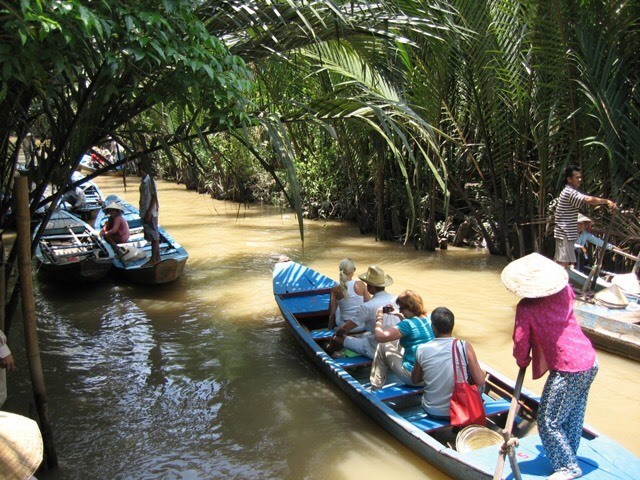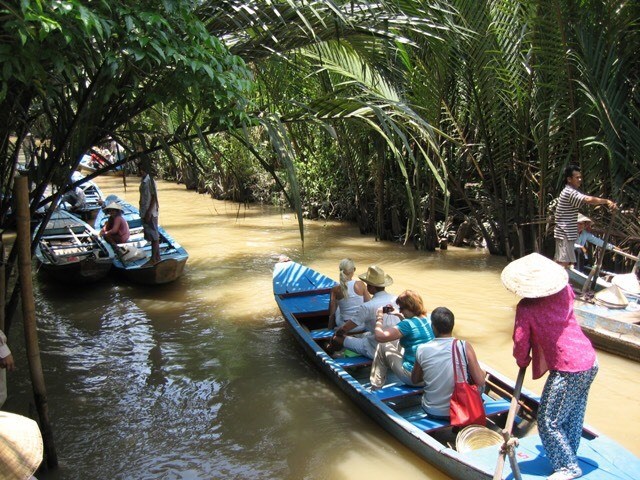



Mekong Delta to improve tourism services (Photo VNA)
Many attractions in the Mekong Delta
have maintained their high traffic since the beginning of the year.
The Department of Culture, Sports, and Tourism of Dong Thap province reported
that the province welcomed 110,000 arrivals in October, up 25 percent
year-on-year. This brought the number of arrivals to 2.5 million in the first
10 months, up 24 percent year-on-year.
Tram Chim National Park, Nguyen Sinh Sac and Xeo Quyt relic sites were
among the popular attractions.
To boost tourism, the province has also promoted ecotourism and created tours
to local fruit gardens.
Nguyen Ngoc Thuong, director of the provincial Culture, Sports, and Tourism
Department, said that development plans, including better infrastructure and
effective promotion campaigns, had brought about positive changes to the
tourism sector.
Around 5.3 million tourists visited Can Tho city in the first eight months of
the year, up 43 percent year-on-year, according to the municipla Department of
Culture, Sports, and Tourism.
The city welcomed 76,700 arrivals during the National Day (September 2) holiday
period, generating more than 48 billion VND (over 2 million USD) in revenue.
The department aims to attract 5.5 million arrivals and earn 2 trillion VND (88
million USD) this year.
Since Kien Giang has the most tourism potential in the Delta, the province in
recent years has been a hotspot for investment, with 274 ongoing tourism
projects on 7,690ha of land, worth 231 trillion VND (10.17 billion USD).
Tran Chi Dung, director of the provincial Department of Culture, Sports, and
Tourism, said that investors had been eyeing Phu Quoc Island, with 218 tourism
projects on 6,445ha of land, worth 222 trillion VND (9.7 billion USD). About 30
projects had been carried out on the island so far.
The province has called for investments to upgrade its infrastructure and build
airports, seaports and roads.
Between 2013 and June 2017, Kien Giang province drew 20.4 million tourists, of
whom 1.1 million were international visitors.
In 2016, the province had 5.6 million arrivals, and of that number, 309,700
were foreigners. Tourists generated a total of 3.67 trillion VND (158 million
USD) in revenue.
The province targets more than six million arrivals this year.
The Mekong Delta has attracted more local visitors compared to the south and
north central coastal areas of Vietnam. However, the number of visitors to the
Red River Delta and the southeast are higher than that of the Mekong Delta.
Also, differences in the number of arrivals between provinces in the Mekong
Delta are noticeable. While foreigners to Tien Giang and Ben Tre provinces
accounted for 50 percent of the total number of international tourists, local
visitors to An Giang province made up one-third of total local tourists.
The Vietnam National Administration of Tourism said that tourism in the Mekong
Delta had gained more recognition, but that it should have been better.
Due to the lack of diverse tourism products, international tourists typically
spend an average 1.95 day and local visitors an average 1.7 day in the region.
Pham Vu Hong, chairman of the Kien Giang province People’s Committee, said that
to meet the demand of visitors, the province would expand the airport, improve
power systems and upgrade infrastructure, and complete them before the
deadlines.
But he said it was also important to invest in more tourism products to extend
visitors’length of stay.
Secretary of Dong Thap province’s
Party Committee Le Minh Hoan said that Dong Thap, Tien Giang and Long An
provinces had collaborated with HCM City to create a tour called "Mot Hanh
Trinh Ba Diem Den" (A journey to three destinations).
Starting from HCM City to Long An, Tien Giang, and Dong Thap provinces,
tourists will be able travel to Tan Lap Floating Village, an ecotourism site,
the Dong Thap Muoi Ecological Reservation Area, and Tram Chim National Bird
Park, among other attractions.
The Mekong Delta Tourism Association has also urged local provinces not to copy
each other’s tourism products as all of them have similar conditions for
tourism.
Tourism experts said that Can Tho city and Phu Quoc island should be key
destinations, while My Tho city could play a support role for tourism in the eastern
area of the Mekong Delta.
Source: VNA